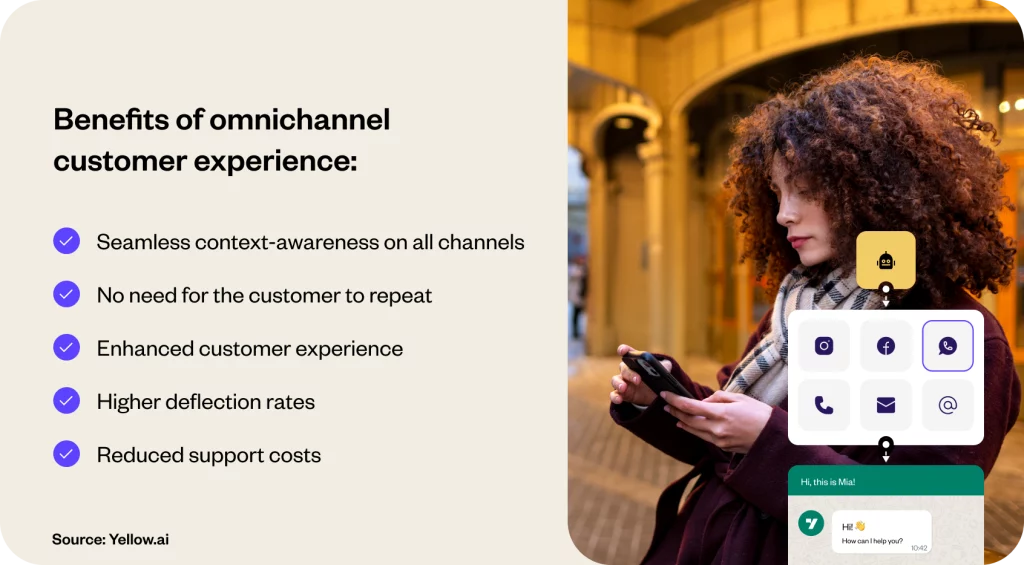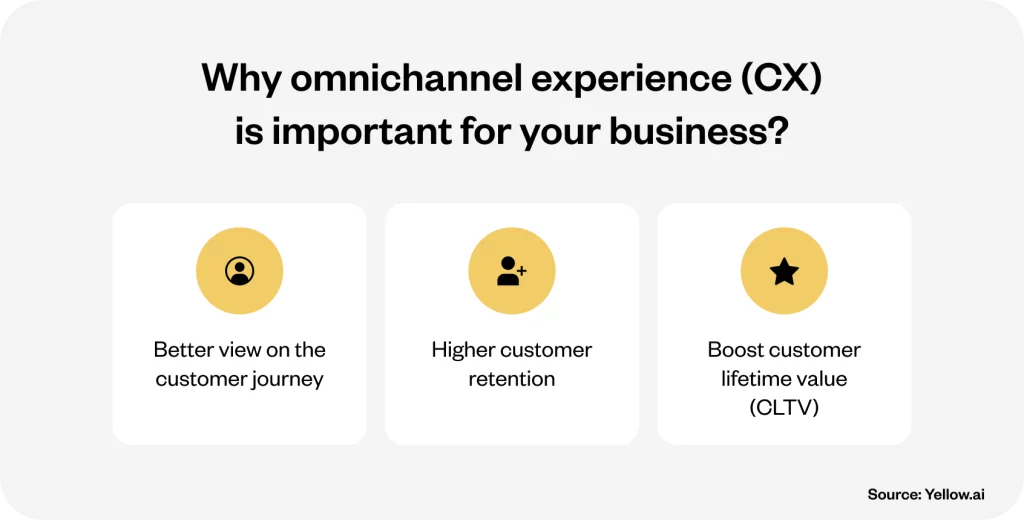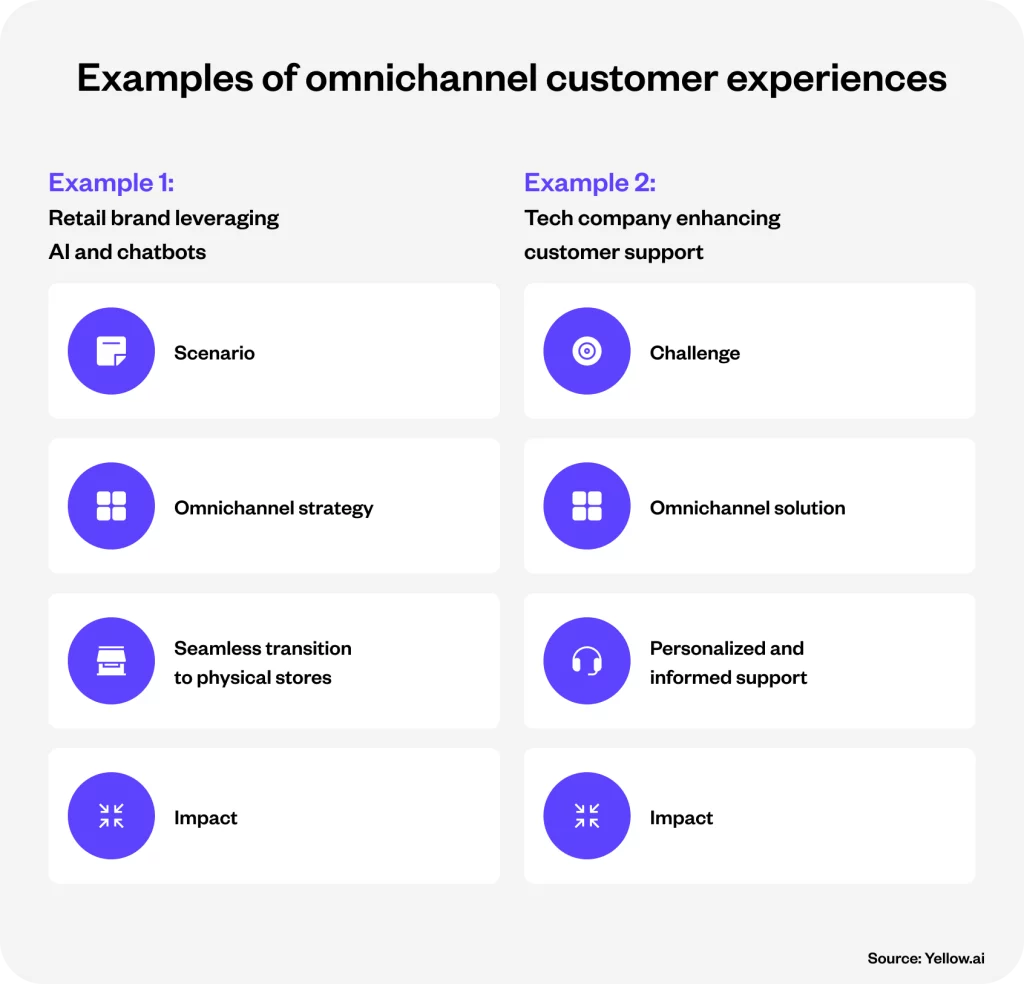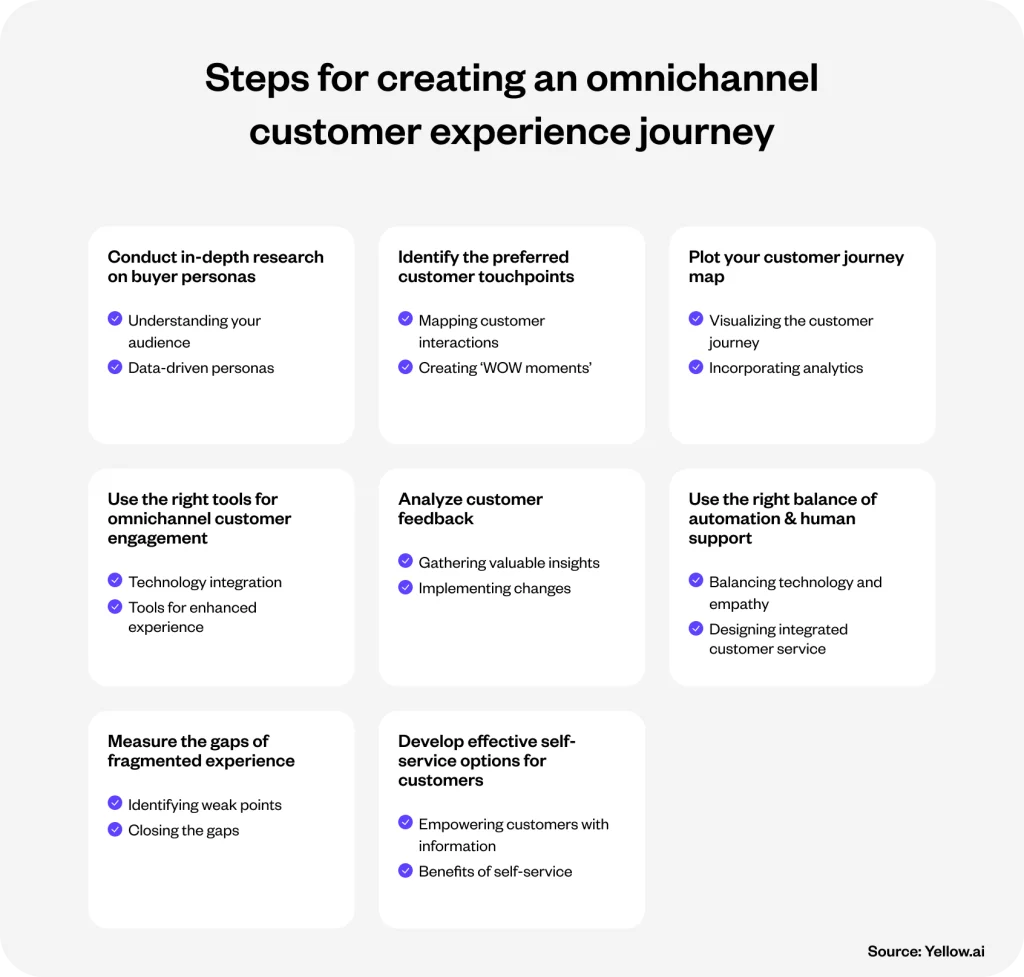Executive summary
Mastering omnichannel customer experience (CX) has become a cornerstone of successful customer interaction and retention strategies. This article explores the essence of omnichannel CX, dissecting its significance and differentiating it from traditional multichannel approaches. We will explore compelling examples, practical steps for implementation, and the transformative impact of technology, specifically the integration of AI and chatbots, in orchestrating a seamless omnichannel experience. Our discussion will highlight how businesses can leverage omnichannel strategies to gain a comprehensive view of customer journeys, enhance customer retention, and significantly boost customer lifetime value (CLTV).
Imagine a world where every interaction with a customer, whether through a website, social media, in-store, or via a mobile app, is seamlessly interwoven to create a cohesive narrative. It is the realm of omnichannel customer experience (CX). This strategy transcends traditional boundaries and offers a unified brand experience to customers, irrespective of the channel or device they choose. With 71% of shoppers using smartphones for in-store research, highlighting the growing importance of integrated digital and physical experiences, businesses must evolve to meet these changing expectations.
Omnichannel CX is not just a trend but a fundamental shift in customer engagement, with statistics showing an impressive 89% customer retention rate for businesses employing robust omnichannel strategies. As we explore the intricate world of omnichannel customer experience, we will uncover how businesses can adapt and thrive in this new era where every touchpoint is an opportunity to enchant and retain customers. With AI and chatbots at the forefront of this revolution, companies can now offer more personalized, efficient, and engaging customer experiences than ever before.

Related must-reads:
- Conversational AI for Customer Experience?
- How to improve customer experience?
- Customer Experience vs. Customer Service
- 10 Key Customer Experience (CX) Trends
What is omnichannel customer experience?
In the modern landscape of customer service and engagement, the term “omnichannel customer experience” has emerged as a pivotal concept for businesses aiming to excel in customer satisfaction and retention. But what does it truly entail?
An omnichannel customer experience is a holistic approach that integrates various channels of customer interactions to provide a consistent, seamless, and highly personalized experience. Unlike traditional methods that operate in silos, omnichannel unifies all platforms – be it online through websites, social media, email, live chat, or offline in physical stores and through phone calls. This integration ensures that customer interactions are not isolated incidents but part of a continuous journey.
Webinar: A comprehensive guide to omnichannel customer experience
An example to illustrate this concept can be found in customer support scenarios. Imagine a customer initiates a query through a live chat on a company’s website. Later, they decide to follow up via a phone call. In an omnichannel setup, the customer service representative on the call would have immediate access to the chat history, allowing them to understand the context without asking the customer to repeat information. This continuity not only saves time but also enhances the customer’s experience, making them feel valued and understood.
The essence of an omnichannel experience lies in its fluidity and coherence. Each channel is interlinked, allowing customers to move effortlessly between them while retaining a consistent narrative and personalized interaction. This approach is not just about convenience; it’s about creating a connected and immersive experience that resonates with the customer at every touchpoint.
Why omnichannel experience (CX) is important for your business?
Omnichannel experience (CX) is not just an innovative approach but a necessity for businesses aiming to thrive in today’s market. The importance of this strategy stems from its ability to create a cohesive customer journey, bolster customer retention, and enhance the overall customer lifetime value (CLTV). Let’s explore why incorporating an omnichannel approach is essential for your business.

1. Better view on the customer journey
The omnichannel approach provides a panoramic view of the customer journey, uniting interactions across various channels into a single narrative. This holistic perspective is crucial for understanding how customers interact with your brand, whether it’s through an app, website, in-store, or customer support. With an omnichannel strategy, every touchpoint is a piece of a larger puzzle, offering valuable insights into customer preferences and behavior.
By mapping out the entire customer journey, businesses can identify key areas for improvement and opportunities for engagement. This comprehensive view allows for a more strategic approach to customer interactions, ensuring each touchpoint is optimized for maximum impact and satisfaction.
Related read: How to personalize customer experiences at scale
2. Higher customer retention
Omnichannel CX significantly boosts customer retention by offering seamless transitions across different channels. Customers expect consistency and ease when interacting with a brand, regardless of the platform. Omnichannel strategies fulfill this expectation by ensuring that the transition from an online chat to a phone call, for example, is smooth and information is retained throughout the process.
This consistency in experience not only increases customer satisfaction but also fosters loyalty. Happy customers are more likely to return and engage with the brand repeatedly, turning them into advocates for your business. The enhanced satisfaction from a seamless omnichannel experience directly correlates with higher retention rates.
Related read: Customer retention: 15 Strategies to improve CR
3. Boost customer lifetime value (CLTV)
Embracing omnichannel CX significantly enhances the customer lifetime value. Statistics indicate that omnichannel customers spend more both online and in physical stores compared to those who engage through a single channel. This increased expenditure is a testament to the effectiveness of a well-executed omnichannel strategy.
By providing customers with multiple avenues to engage and shop, businesses increase the likelihood of repeated interactions and purchases. Customers value the convenience and personalization that omnichannel strategies offer, leading them to choose your business as their preferred brand. This long-term loyalty also ensures sustained revenue over the customer’s lifetime.
Multichannel vs omnichannel experience
We’ve already delved into the intricacies of omnichannel communication, now let’s turn our attention to something people often confuse with it, albeit mistakenly – the multi-channel experience. Though multi-channel and omnichannel are terms frequently used synonymously, they embody distinct approaches to customer engagement. It’s important to explore what differentiates these two concepts and why recognizing this distinction is vital for businesses.
Related read: Omnichannel vs multichannel customer service – What is the difference?
What is multichannel experience?
The multi-channel experience refers to the use of multiple channels for customer interaction, but with each channel operating in isolation. This approach focuses on the availability of various platforms – such as email, social media, phone calls, and physical stores – for customer engagement. However, these channels often function independently, without sharing information or context.
For example, a customer who inquires about a product via email and then follows up with a phone call may find that the phone representative has no record of the previous interaction. Each channel in the multichannel approach provides a separate experience, leading to potential repetition and inconsistency in customer service.
The key differences between multichannel and omnichannel
- Integration vs. isolation: In omnichannel, all channels are integrated, sharing data and context, whereas multichannel experiences are isolated, with each channel functioning independently.
- Consistency vs. fragmentation: Omnichannel offers a consistent experience across all platforms, while multichannel can lead to a fragmented experience with varying degrees of service and information on different channels.
- Customer journey focus: Omnichannel focuses on the entire customer journey, ensuring continuity and personalization, while multichannel focuses on individual interactions without considering the overall journey.
- Data utilization: Omnichannel leverages shared data across all channels for better customer insights and service, whereas multichannel lacks this holistic data integration.
Examples of omnichannel customer experiences
The implementation of an omnichannel customer experience strategy can be transformative for businesses. It’s not just about unifying communication channels; it’s about crafting a customer journey that is seamless, personalized, and highly responsive. To illustrate this, let’s explore two examples where technology-driven omnichannel strategies were effectively employed to elevate customer experiences.

Example 1: Retail brand leveraging AI and chatbots
Scenario: A leading retail brand sought to bridge the gap between their online and offline customer experiences. Their challenge was to create a unified narrative across their website, mobile app, social media platforms, and physical stores.
Omnichannel strategy: The brand introduced AI-powered chatbots on their website and social media channels, which were integrated with their CRM system. These chatbots provided personalized product recommendations based on customer browsing history and previous purchases.
Seamless transition to physical stores: When customers visit the physical stores, the sales representatives, equipped with tablets, can access the customers’ online interaction history. It enabled them to offer personalized assistance, suggesting items that complemented the customer’s previous purchases or online interests.
Impact: The seamless integration of online and offline channels led to a significant increase in customer satisfaction. The brand saw a rise in repeat purchases and an enhanced customer lifetime value, attributable to the personalized and consistent experience across all touchpoints.
Example 2: Tech company enhancing customer support
Related read: How to Automate Customer Support?
Challenge: A global technology company faced challenges in managing customer support queries coming in through various channels, leading to repeated information and disjointed customer experiences.
Omnichannel solution: They implemented an omnichannel customer support system powered by Yellow.ai. This system centralized queries from emails, social media, live chats, and phone calls into a single platform.
Personalized and informed support: With the omnichannel system, customer service agents had a complete view of each customer’s history, regardless of the channel. It allowed them to provide informed and consistent support. The AI chatbot integrated into this system could handle basic queries and gather preliminary information before routing more complex issues to human agents.
Impact: The tech company witnessed a significant decrease in response time and an increase in customer satisfaction scores. The omnichannel approach provided customers with a sense of being valued and understood, as their issues were resolved more efficiently without the need to repeat information.
Steps for creating an omnichannel customer experience journey
Creating a successful omnichannel customer experience journey is vital for businesses aiming to meet the evolving expectations of modern consumers. This process involves a series of strategic steps to ensure that every customer interaction across various channels is coherent, integrated, and focused on delivering a seamless experience. Let’s explore the essential steps to build an effective omnichannel journey.

1. Conduct in-depth research on buyer personas
Understanding your audience: The first step is conducting thorough research to understand your target audience deeply. By developing detailed buyer personas, you gain insights into customer preferences, behaviors, and pain points. This knowledge is crucial for tailoring your omnichannel strategy to meet the specific needs and expectations of different customer segments.
Data-driven personas: Utilize demographic, behavioral, and survey data to create accurate personas. These personas should guide your decision-making process, ensuring that your omnichannel strategy resonates with your target audience, thus improving customer experiences and aligning with their expectations.
2. Identify the preferred customer touchpoints
Mapping customer interactions: Identify where and how your customers prefer to interact with your brand. Whether it’s through social media, email, phone calls, or in-store visits, understanding these touchpoints allows you to optimize each for better customer engagement.
Creating ‘WOW moments’: By recognizing these key interaction points, you can exceed customer expectations and create memorable experiences. This understanding helps in personalizing interactions and setting benchmarks for excellent customer service across all channels.
3. Plot your customer journey map
Visualizing the customer journey: Develop a customer journey map that outlines every step of the customer’s interaction with your brand. This map should include all possible touchpoints and channels, highlighting the customer’s path from discovery to purchase and beyond.
Incorporating analytics: Apply customer experience statistics and analytics to your journey map. This approach helps in understanding customer interactions across channels and devices, enabling you to create a unified and satisfying omnichannel experience.
4. Use the right tools for omnichannel customer engagement
Technology integration: Implementing the right digital tools is critical for facilitating omnichannel engagement. These tools should enable seamless data flow and real-time responses across various customer touchpoints.
Tools for enhanced experience: Utilize chatbots for 24/7 engagement, live chat for real-time assistance, and live engagement tools like co-browsing and video calls to provide personalized and efficient solutions.
5. Analyze customer feedback
Gathering valuable insights: Collect and analyze feedback from various channels. This feedback is a goldmine of information, providing insights into customer satisfaction and areas needing improvement.
Implementing changes: Use this feedback to refine your omnichannel strategy. Regular analysis and action on customer feedback help reduce friction, solve customer problems, and enhance the overall experience.
6. Use the right balance of automation & human support
Balancing technology and empathy: Find the perfect balance between automated solutions like chatbots and human interaction. This balance is essential for catering to both efficiency and the need for empathetic, personalized experiences.
Designing integrated customer service: Ensure that your strategy includes seamless transitions between automated and human support, maintaining a consistent and empathetic customer experience throughout the journey.
Success story

7. Measure the gaps of fragmented experience
Identifying weak points: Regularly assess your omnichannel strategy to identify any gaps or inconsistencies in the customer experience. As customer habits evolve, your approach should adapt to meet these changing preferences.
Closing the gaps: Focus on bridging these gaps to deliver a more cohesive and satisfying customer experience. Keep an eye on data integration across channels to avoid inconveniences that might affect the customer journey.
8. Develop effective self-service options for customers
Empowering customers with information: Implement self-service portals that provide customers with instant access to information. These portals can include FAQs, tutorials, and manuals to help customers resolve their issues independently.
Benefits of self-service: Such portals not only save time and resources but also improve the customer’s perception of your brand. Personalized self-service options lead to more positive brand recommendations and educate customers for future interactions.
Success story

How Yellow.ai can help level up your customer experience
Yellow.ai stands at the forefront of revolutionizing customer experience with its advanced AI and chatbot technologies. Here’s how Yellow.ai can be a game-changer in enhancing your omnichannel customer experience:
- AI-powered chatbots: Yellow.ai’s sophisticated AI chatbots understand and respond to customer queries in real time, providing a seamless experience across all digital channels.
- Personalized interactions: The platform offers personalized customer interactions, leveraging customer data to provide tailored recommendations and solutions.
- Unified customer view: Integrating various customer interaction points, Yellow.ai provides a unified view of the customer journey, ensuring consistency and personalization across all channels.
- Analytics and insights: With in-depth analytics, Yellow.ai helps in understanding customer behavior and preferences, enabling businesses to make data-driven decisions to enhance CX.
- Scalability and flexibility: Yellow.ai’s solutions are scalable and flexible, allowing businesses to expand their customer service capabilities as they grow.
Take the first step towards a superior omnichannel journey

Summing up the omnichannel experience
Embracing an omnichannel approach is no longer an option but a necessity in the rapidly evolving business landscape. By adopting strategies that ensure a seamless, integrated, and personalized customer journey across all touchpoints, businesses can significantly enhance customer satisfaction, loyalty, and value. The future of customer experience is in creating these connected, memorable journeys, and the time to adapt is now.
Frequently asked questions (FAQs)
Why is omnichannel important for customer experience?
Omnichannel is crucial for customer experience because it ensures seamless, consistent, and personalized interaction across all channels. It allows customers to switch between different platforms while maintaining continuity in their journey, leading to increased satisfaction and loyalty.
How can you improve omnichannel customer experiences?
Improving omnichannel customer experiences involves integrating all customer touchpoints, using data-driven insights for personalization, implementing advanced technologies like AI and chatbots for real-time interactions, and continuously analyzing customer feedback to make necessary adjustments.
How do you build an omnichannel customer experience?
Building an omnichannel customer experience requires a strategic approach that includes understanding customer personas, mapping out the customer journey, utilizing the right technological tools, balancing automated and human interactions, and consistently analyzing and refining the strategy based on customer feedback.
What is the difference between omnichannel vs. multichannel customer experience?
The key difference lies in integration and consistency. Omnichannel customer experience is about providing a unified and cohesive experience across all channels, where data and context are shared seamlessly. In contrast, multichannel experience involves using multiple channels but often in isolation, leading to fragmented and inconsistent interactions.






















